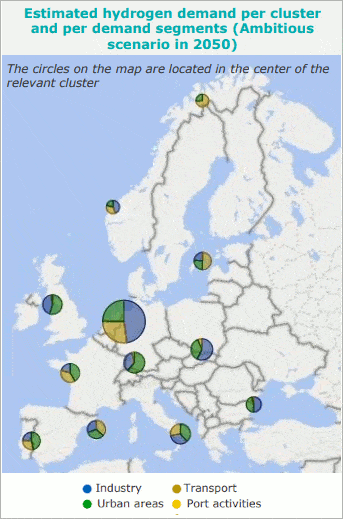
In 2050, up to 42% of total hydrogen demand in the EU, which is expected to amount to around 53 million tonnes (or 1,764 terawatt hours), i.e. a share of 22 million terawatt hours tons (or 730 TWh), could be located in the areas Port. This is highlighted by a study conducted by Deloitte Belgium for the Clean Hydrogen Partnership, the public-private partnership for research and development of energy technologies for cells fuel and hydrogen in Europe. Noting that the EU must significantly accelerate the deployment of the capacity of production infrastructure, import terminals, conversion, storage, transport and consumption of hydrogen in port ecosystems in order to achieve its objectives of renewable hydrogen for 2030, the study points out that ports will play a crucial role in the expansion of the European hydrogen market, primarily as a transit hub energy that facilitate the import of hydrogen and its distribution and, secondly, as investors in dedicated infrastructure to produce, import, store and Distribute hydrogen to more end users in areas ports and inland.
The study notes that hydrogen demand in port areas European should be driven mainly by industries and the international maritime transport sector, which - according to THE ANALYSIS - in 2050 they will represent 42% and 42% respectively 31% of total demand in port areas.
 The study predicts that the largest cluster of demand for hydrogen (Belgium, Netherlands, Denmark and northern Germany) it will depend heavily on the import of green hydrogen and blue (between 40% and 80% of total hydrogen consumption) from mainly from North Africa (Morocco, Egypt, Algeria), Middle East (Oman, Saudi Arabia, Qatar) and even beyond (for example, like Australia). The report specifies that they can be expected also some intra-European hydrogen exports and imports (e.g. from Spain to France).
The study predicts that the largest cluster of demand for hydrogen (Belgium, Netherlands, Denmark and northern Germany) it will depend heavily on the import of green hydrogen and blue (between 40% and 80% of total hydrogen consumption) from mainly from North Africa (Morocco, Egypt, Algeria), Middle East (Oman, Saudi Arabia, Qatar) and even beyond (for example, like Australia). The report specifies that they can be expected also some intra-European hydrogen exports and imports (e.g. from Spain to France).
'The acceleration of hydrogen infrastructure in ports and their capacity as transit hubs of hydrogen - said Bart Biebuyck, executive director of the Clean Hydrogen Partnership - represents an important step Towards the construction of the hydrogen economy and our study It clearly demonstrates this. With ports and industrial coastal areas which should account for 42% of the annual demand for hydrogen across the EU, we must work together to develop a "European Roadmap of Hydrogen Ports" that can Unlocking the full decarbonisation potential of areas dockers'.
The Clean Hydrogen Partnership also highlighted that a unique feature of the study conducted by Deloitte Belgium is the specific results for each of the 427 seaports, and European interiors examined in relation to future demand for hydrogen, supply, the relative reduction of CO2 equivalent, and the infrastructure needed for each period (2030, 2040 and 2050) and the envisaged scenarios are freely accessible via a Dynamic online dashboard that accompanies the report. Clean Hydrogen Partnership explained that the dashboard provides Clear information to each port authority and others Parts of the economic-port community on the potential of Demand for hydrogen in its port ecosystem and its CO2 reduction, from where and at what cost it could be Satisfied this demand and what infrastructure and investments may be needed to unlock full potential of the hydrogen economy in each individual port.